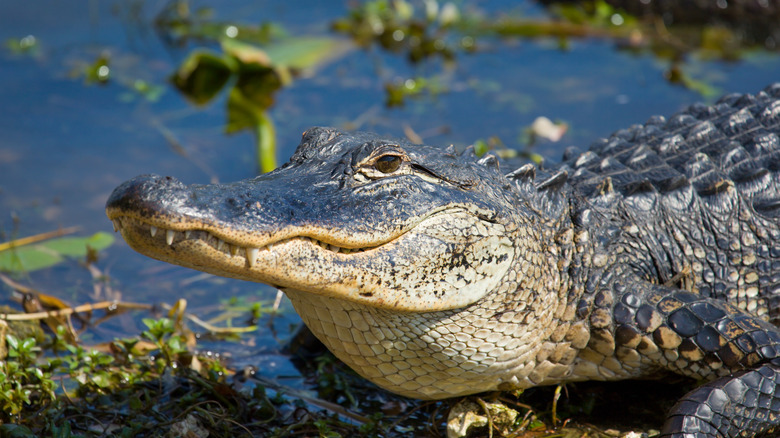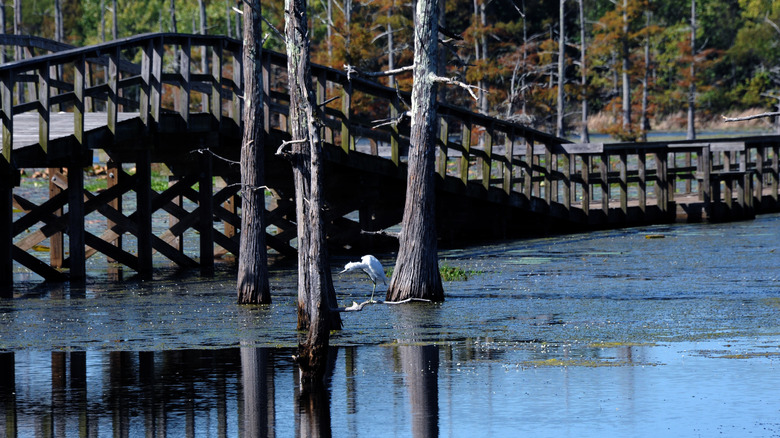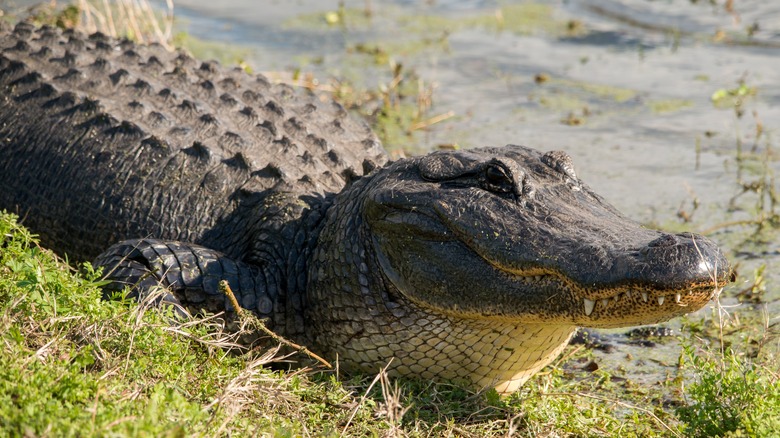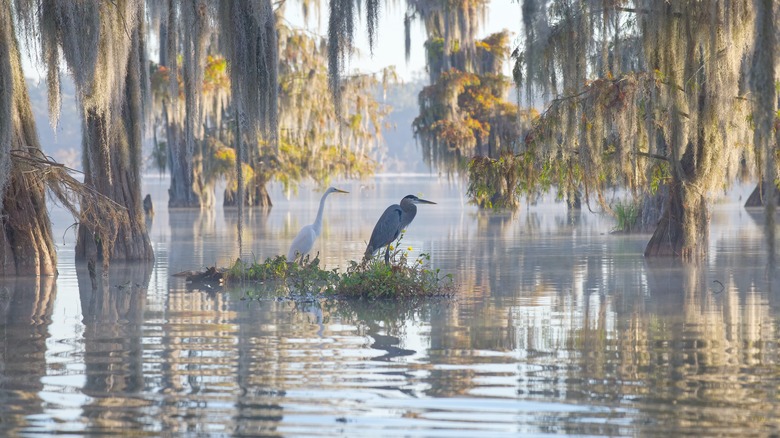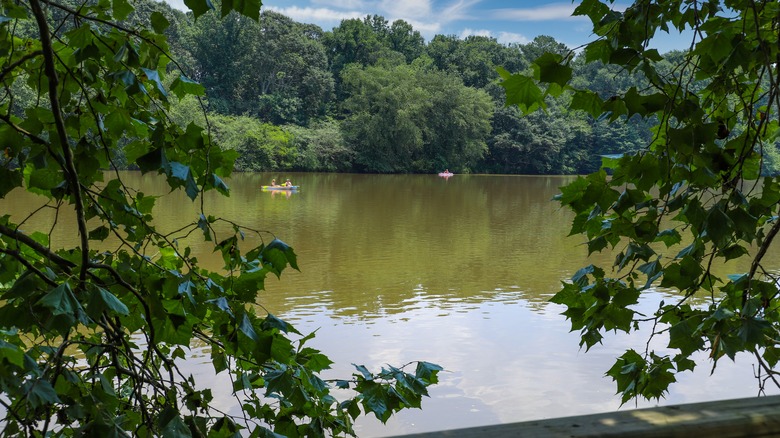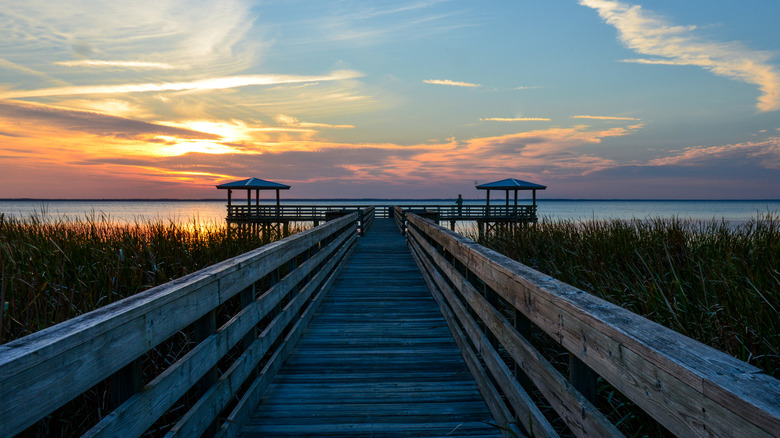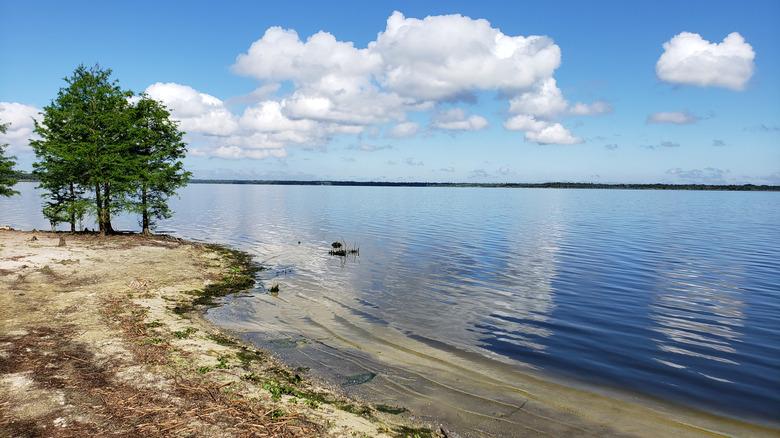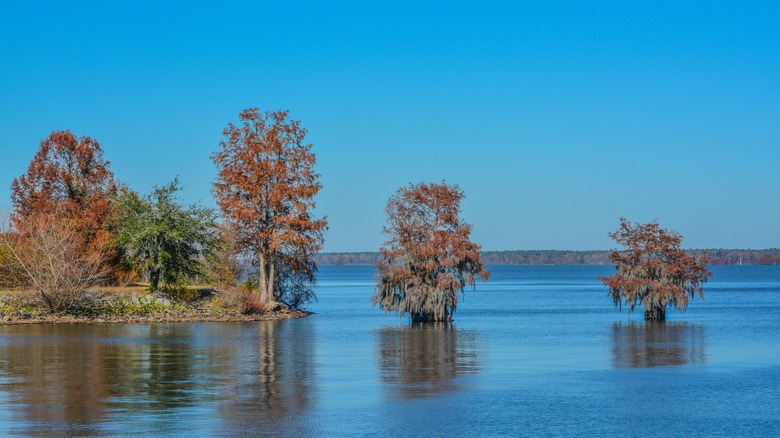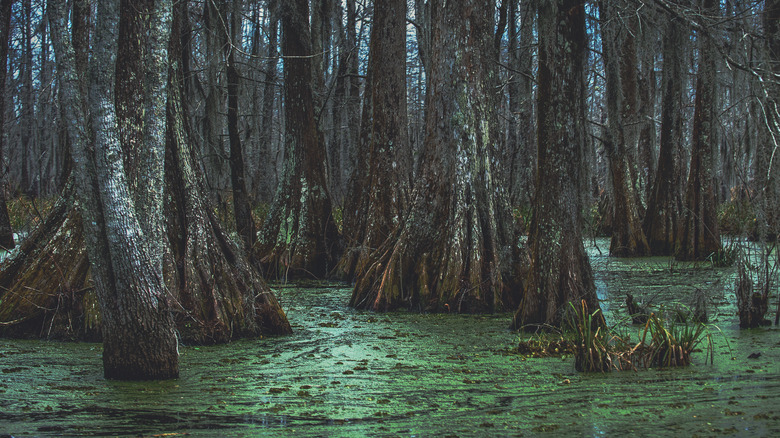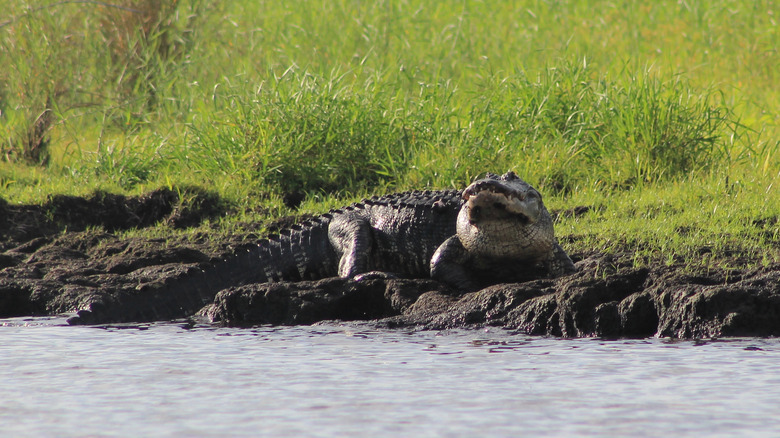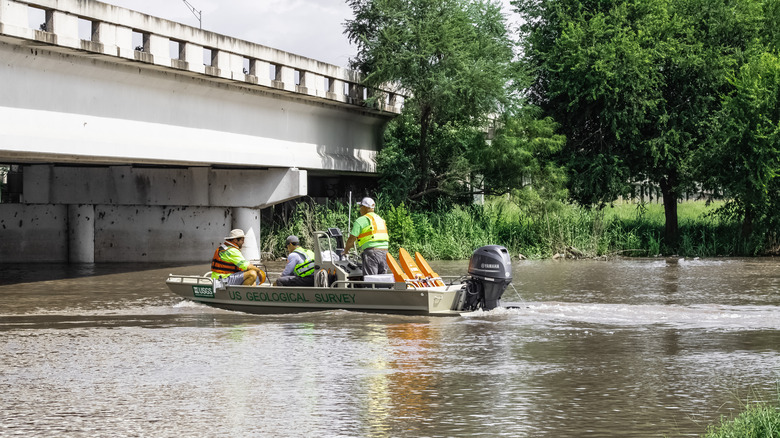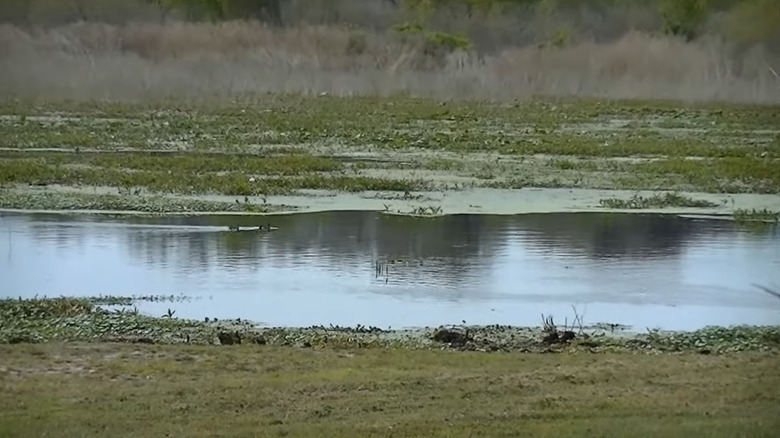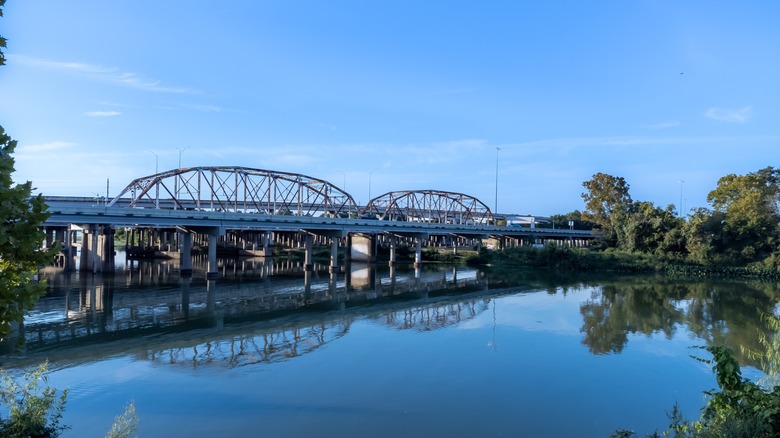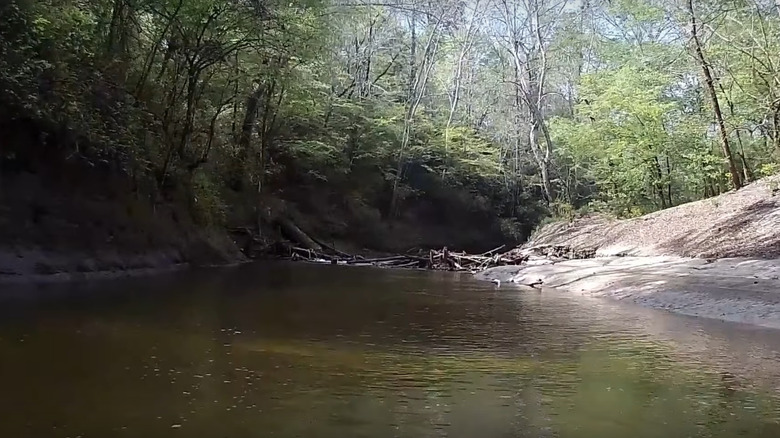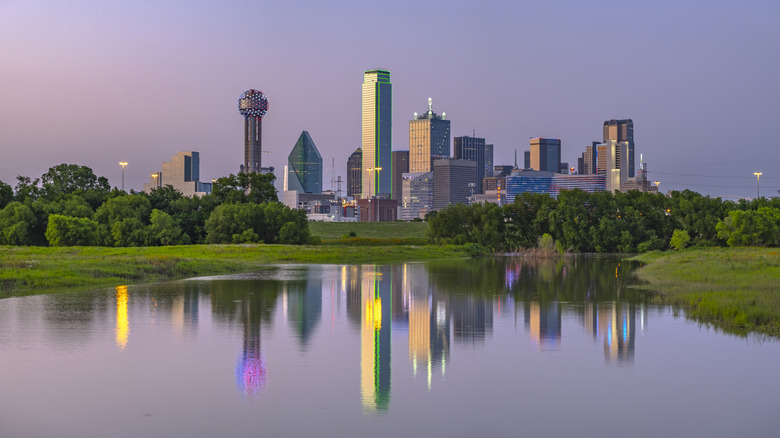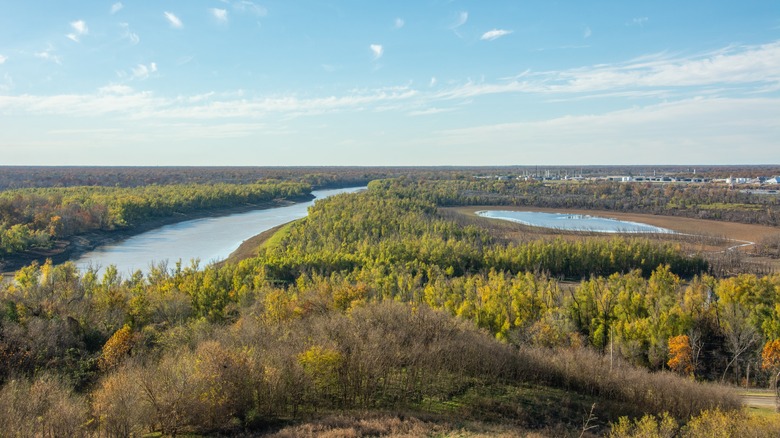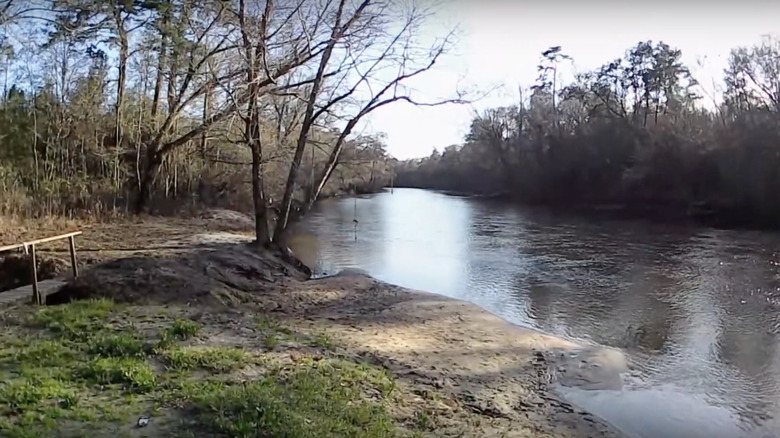Avoid Swimming At These Alligator And Crocodile-Infested Waters Across The US
Many people might wonder what the difference is between crocodiles and alligators, and the answer is not a whole lot when you're trying to avoid them. Alligators have darker skin than crocodiles and a more rounded nose. They are found in freshwater — lakes, streams, and rivers — unlike crocodiles, which generally survive in salt water, often near the coast. Perhaps the easiest way to spot the differences between them is by their teeth. A crocodile's bottom fourth tooth on each side always sticks out when its mouth is closed, whereas an alligator's slides into the upper jaw.
Both alligators and crocodiles live across parts of the Southeastern U.S., though crocodiles number about 2,000, are considered an endangered species, and are only found in parts of Southern Florida (per the Florida Fish and Wildlife Conservation Commission). Alligators are far more plentiful; about 5 million inhabit the country, and a quarter are in Florida (via Defenders of Wildlife). While alligators are quiet, solitary creatures that shy away from people, they can, and do attack for no apparent reason — like the time when a gator snatched and killed a boy in Disney World in 2016. That said, alligator attacks are rare, with 28 fatalities in Florida from 1948 to 2022. Nevertheless, these amphibians are powerful creatures that can grow to more than 15 feet in length and weigh in excess of 1,000 pounds. They are also unpredictable, so the best way to avoid conflict is to keep away from the waters where they live.
Black Bayou Lake National Wildlife Refuge, Louisiana
Due east of Shreveport, this park is anchored by a 1,600-acre lake. Visitors can admire the lake from a winding boardwalk trail that skirts the water; a pier even juts out over the shallows, allowing for unrestricted views. Standing on its end, sightseers can enjoy the scenery, from the bald cypress trees to the abundant wildlife that calls this part of Louisiana home.
Among the animals here are prothonotary warblers: small, compact, lyrical birds with brilliant yellow torsos, great blue herons, and the sharp-shinned hawk. The swampy area is also home to anhingas, lots of different frog species, and a resident population of American alligators. Many visitors opt to watch them from afar, though the braver ones can make use of boat ramps or entry points to take to the water by boat or kayak for a closer inspection. They do that at their own risk, of course.
Brazos Bend State Park, Texas
For anyone living in Houston or visiting for business or pleasure, this park is easy to reach — it sits southwest of the sprawling city. It's a piece of nature well set up for exploration, with almost 40 miles of trails, some suitable for traversing on a wheelchair. Some trails are short and good for getting a handle on the environment. For instance, The Creekfield Lake Nature Trail is fully paved and extends for less than a mile. It cuts through wetlands and features showcases depicting wildlife and an observation area for looking over the ecology. Cycling and hiking trails meander around the lakes that are in the park, and leashed pets are allowed on them.
But park authorities warn against pooches entering the lake or drinking its water because of what lies below the surface. Across the 1,000 acres of lake in the park, there are estimated to be 250 alligators in and around the water (via Texas Parks and Wildlife Department ). The best chances of spotting alligators are at Elm Lake and 40-acre Lake, with spring and fall being the optimum months to encounter a gator.
Caddo Lake, Louisiana-Texas
Straddling two states, this is the only natural lake in Texas and is known for alligator sightings. It's a popular lake to explore, and visitors to the lake on the Texas side can visit Caddo Lake State Park. They might walk on trails that take in bald cypress trees, their branches and limbs somewhat shrouded by the fine gossamer of Spanish moss. Another option is to get out on the water on a kayak or canoe and paddle through the still bayous, where the scenery appears both serene and haunting.
The waters of the lake, which is more than 28,000 acres in size, are home to over 70 species of fish (per the Florida Fish and Wildlife Conservation Commission), making them a prized realm for anglers. While swimming is allowed in the park, it's best to do it during the brightest part of the day, if you really must. Alligators tend to be most active in the hours around sunrise and sunset. That said, even if you like and know the best places for swimming with sharks, do you really want to wade into the water where gators have free rein?
Chattahoochee River, Georgia
For anyone searching for a relaxing waterside stroll in this part of Georgia, a state with one of the cheapest beach getaways in the U.S., the RiverWalk is a fine choice. The 15-mile park, which stretches along the Chattahoochee River, traces the banks of a waterway that begins its life in the mountainous terrain in the north of Georgia and courses down to the Gulf of Mexico on the coast of Florida. This is a pleasant arena to take in the scenery that is both urban and rural, with slices of greenery interspersed by bridges, buildings, and the broad river.
Alligators seem to also be taken by the surroundings — in late 2023, about 30 gators were spotted relaxing by the Chattahoochee RiverWalk, not far from Columbus. They were enjoying the river and sun, but the local sheriff's office warned leisure seekers to keep away, especially kids. According to an official from the Georgia governmental department that deals with game management, sightings like this could be expected on large waterways like the Chattahoochee River.
Lake George, Florida
A commenter on Tripadvisor, based in Orlando, described this waterway as a treacherous spot: "Big Florida lake — lots of gators. Lots of snakes. Didn't go in the water." The lake borders the state-gazetted Lake George Wildlife Management Area, a natural realm that unravels across about 40,000 acres. The environment mixes pine flats with swamps where hardwoods tower over the water, and it's home to a large array of animals.
Although Florida teems with top-rated islands ideal for a vacation, it offers more than a serene haven. Adventurers who visit Lake George to fish or take a boat trip on the waterways might spot tortoises, white-tailed deer, ospreys, Florida black bears, and bobcats. There is also the chance to see alligators, big ones, too! About a decade ago, a couple that owned a seafood business was hunting in Lake George and caught a gator almost 14 feet in length. They estimated they'd get over 200 pounds of meat from the creature, which puts its size into detailed perspective.
Lake Jesup, Florida
When an alligator grows to about 6 to 7 feet from snout to tail end, it's ready to reproduce. Each year, around the beginning of April, alligators start to entertain ideas of finding a mate, and mating takes place in May and June. Females lay their eggs in a mound in the peak of summer and can produce about 50 eggs, which they have to incubate for a couple of months. Late summer to early fall is when the little alligator offspring hatch. As Florida warms up in the spring, love is definitely floating in the wind in alligator country, and these animals are noticeably more active.
So much so that operators like The Black Hammock declare that it's a good time for visitors to take trips on its airboats to see gators. Spots like Lake Jesup are known to be dependable locations for seeing them during this amorous period, though travelers are warned to always keep a distance from the animals.
Lake Marion, South Carolina
The highest number of alligators in the state live in this lake, a curving body of water located northwest of Charleston. It's also one of the best U.S. towns for a destination wedding. It's the biggest lake in South Carolina, stretching about 100,000 acres, with approximately 500 miles of shore. Lake Marion forms part of a reservoir system and was created for a hydroelectric power project. It has a large stock of fish in its waters. Anglers prize the environment, home to catfish, striped bass, bream, and more.
There is an eerie quality to the lake, with stumps of trees and trunks around and within its water. Visitors will also see lots of inlets, coves, and areas of wetland — creating ideal places for alligators to lay low. According to The Sumter Item, the entire state is estimated to have 100,000 alligators spread within its boundaries, and Lake Marion is thought to be home to about 1,000 of them. In 2022, a 625-pound, 13-foot gator was even caught here.
Lake Martin, Louisiana
This small lake can be reached as an easy destination from Baton Rouge — it's about an hour away by car. Part of it is a natural preserve, an area of swamps, Spanish-moss-covered trees, and still waters. The environment is home to many wading and water birds, from herons and egrets to ibis and spoonbills. It's also where to find the nutria rodent, turtles, lizards, and snakes. Alligators reside here, sometimes lounging at the edge of the lake.
While they generally won't bother onlookers — unlike the dangerous animals you wouldn't want to see in the Amazon Rainforest — they are still creatures to be feared and avoided. Visitors can spy them from the road that runs around the lake or, for a closer, more intimate option, from atop the water. Adventurers can bring their own kayak to the lake or rent one from operators like Champagne's Swamp Tours. You can also take a boat ride with the tour company; as the vessel glides through the water, look out for gators that can be up to 14 feet in length.
Lake Okeechobee, Florida
This large lake is a short distance from West Palm Beach and is big enough that some refer to it as an inland sea. It's not that Florida, with its long stretches of coastline, lacks seas. This is the biggest lake in the southeast, and its name translates to "big water" from the Seminole language. The lake is shallow, and the water rarely goes deeper than 9 feet. This, coupled with Florida's proliferation of wetlands, makes it an ideal alligator habitat. Lake Okeechobee is also near a cute Florida town known as the sweetest place in America.
For anglers, the lake is a huge draw, with largemouth bass, catfish, crappies, and speckled perch among the prize catches. For outdoor types, there are hiking trails around the lake, and also the chance to get on its water using a boat or kayak. Clearly, plenty of reasons attract visitors to "Lake O," as it's often locally called; however, it's also a magnet for alligators. According to approximations by The Ledger, 30,000 alligators live here, making it the most populated lake in the state in terms of gator count.
Nueces River, Texas
A river that extends about 300 miles, the Nueces River winds its way through the Lone Star State until its terminus, where it flows into Nueces Bay and the Gulf of Mexico. It varies along its length, and some sections are very scenic. One part, near George West, is even designated as a paddling trail. Extending for a little over 4 miles of the river, the trail brings flora and fauna into focus. Paddlers will be able to see turtles, avian life, sunfish, and catfish along the route.
They will also have the chance to spot alligators on this bit of the river. It's not the only part of the Nueces River where alligators live, however. In May 2023, at an intersection not far from the Nueces River closer to Corpus Christi, sheriffs had to deal with a 6-foot gator that was relaxing outside a convenience store. After the creature was captured by animal control, it was returned to the river.
Orange Lake, Florida
Not far from the city of Gainesville, Orange Lake is both a body of water and the name of a community on its banks. The waterway is one of the larger lakes in the area, more than 12,500 acres in size, and sits in the north-central part of the Sunshine State. Sightseers can come here to admire the lily pads that populate the surface or venture into areas teeming with sunfish and largemouth bass for fishing. Some might even head to a pier in the southern section of the lake to drop a line.
But anyone wanting to slide into the lake for a cooling dip should think again. According to A-Z Animals, the lake contains over 2,500 alligators (via Gainesville Sun). And some of them get very big. Orange Lake holds the record for the heaviest alligator caught in the state in 1989, and it weighed more than 1,000 pounds.
San Jacinto River, Texas
At this river that flows along the east of the state and passes through Houston, alligators aren't the only cause for concern. Visitors might also encounter snakes, spiky thorns that can prick the skin, ticks that can burrow underneath it, and tripping-hazard logs in the water. The latter can be especially dangerous for kayakers; one swipe from a heavy, powerful trunk can knock a kayaker upside down.
The alligators are an equally real danger, and though they might be just lazing on the side of the river, minding their own business, they can be very unpredictable during nesting season when protecting their offspring. Some parts of the river, which are swampy, more like bayous, can be especially perilous for swimmers. One commenter on a message board for people who fish from kayaks in the San Jacinto River recalled seeing alligators as long as 12 feet in the river.
Sepulga River, Alabama
Kayakers might know about the Sepulga River Canoe Trail, a stretch of water almost 30 miles in length. It's a pretty ribbon of river in the south of the state and is calm enough that even novice kayakers won't feel intimidated. Trees like pines flank the riverbank. Birders can pull out their binoculars and scan the branches for swallows or buntings, while Mississippi kites sometimes soar and glide overhead. Another animal sighting is likely to be that of alligators, often seen sunning themselves on the riverbank rocks.
While alligators typically favor swampy ecosystems and large rivers, even waterways like the Sepulga River, which isn't noted for its grand dimensions, provide the right conditions for them to prosper. Gators aren't the only thing to fear here. According to a local witness, a mysterious, shaggy-haired arms, black creature was spotted about a decade ago crossing a bridge over the river. For believers in Bigfoot, head on down to the Sepulga River.
Trinity River, Texas
A river of multiple forks, the Trinity River flows for hundreds of miles, entirely inside Texas. Close to Fort Worth, for example, this river is a natural habitat for alligators. Sections near Lake Worth, for instance, including on the lower part of the lake, are where gators have been seen. What makes this river a place where visitors must take care is the environs that it intersects. The river has a basin of thousands of square miles, touching 37 counties in the state.
The human population of the basin area is more than 3 million (via Texas State Historical Association), with large centers being Dallas and Fort Worth. The river varies from broad sections to slender channels, and species of woods line its banks. The variety of terrain and waterscape has allowed alligators a place to thrive among densely populated hubs. In 2015, local authorities removed a 10-foot gator from the river near Downtown Fort Worth. Even though it didn't present an immediate danger to the city's populace, the risk of an unforeseen mishap was deemed too great to leave it there.
Yazoo River, Mississippi
Named for a local Native American tribe, this river was formed when the Yalobusha and Tallahatchie rivers met north of Greenwood. It flows into Louisiana before draining into the sea. It's among the country's most endangered rivers, threatened by large-scale agricultural development that will destroy vast sections of its wetlands. This would spell disaster for the natural environment and the alligators that live in the river.
In the summer of 2023, the longest alligator in Mississippi history was caught in the Yazoo River near Vicksburg. Weighing more than 800 pounds, it was longer than 14 feet and had already been captured many years earlier, evidenced by a metal tag on its foot. While the alligator population in Mississippi is no match for places like Florida — there are estimated to be less than 40,000 in Mississippi (per the Mississippi Department of Wildlife) — the gators are certainly large. One of the reasons for this is that the alligator hunting season in Mississippi is short, less than two weeks, compared to almost three months in Florida.
Yellow River, Alabama-Florida
Parts of this river are protected from development, so alligator numbers have been left undisturbed and have been able to flourish. The river is more than 100 miles in length, originating in Alabama before crossing into Florida and draining into a bay near Pensacola. More than half of the river area is flanked by forests, and visitors paddling along its waters will enjoy some picturesque landscapes as they glide along. Hunting season for alligators in Alabama is a short window, much narrower than in Florida.
In the south of the state, certain areas of the river are known for spotting alligators. At Givens Bridge, on the edge of the Conecuh National Forest, it's easy to get a kayak into the water, and since the current isn't too strong, navigating isn't an issue. In addition to deer, fox, and wild turkeys on land, alligators can be seen in and out of the water.
